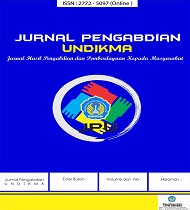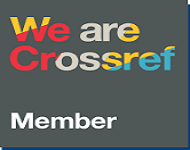Students' Perceptions, Creative Thinking Skills, and Practicum Results in Online and Offline Models
DOI:
https://doi.org/10.33394/jk.v8i4.6240Keywords:
Student Perceptions, Practicum Results, Creative Thinking Skills.Abstract
This study aims to describe perceptions, practicum results, and students' creative thinking skills in online and offline practicums. This research is ex post facto. The subjects of this study were 70 students of the 2016 and 2017 batches of the Department of Biology Education, University of Muhammadiyah Malang. The two batches experienced different treatments; the 2016 batch took offline practicums, while the 2017 batch took practicums online due to the Covid-19 pandemic. The research instruments consisted of (1) student perception sheets, (2) tests, and (3) creative thinking skills assessment instruments. Data were analyzed descriptively and inferentially using one-way ANOVA and Hotelling's T2. The study results show students' perceptions of offline and online practicum. Students tend to understand the material better in offline practicum than online, and students also think that offline practicum is more interesting than online. Other findings indicate that students find it difficult to understand procedures in online practicums compared to offline ones. In addition, students experience technical problems in offline practicums, especially those related to networks. In contrast, technical issues can be overcome in online practicums because students can consult directly with practicum assistants. Analysis of student practicum results shows no difference between offline and online practicum results from the aspects of understanding and activeness. Meanwhile, from the aspect of report value, the online practicum is better than the offline one. This study also shows that students' creative thinking skills in offline practicums are higher than online in terms of the four aspects of creative thinking and three aspects of assessment, namely data analysis, work methods, and lists of references. In general, student perceptions, practicum results and creative thinking skills in offline practicums are better than in online ones.
References
Alwi, S. Z., & Suherman, S. (2020). The Effect of Practical Learning on Creative Thinking Skills of High School Students on Acid-Base. Jurnal Akademika Kimia, 9(4), 213-218.
Anwar, M. N., Shamim-ur-Rasool, S., & Haq, R. (2012). A comparison of creative thinking abilities of high and low achievers secondary school students. International Interdisciplinary Journal of Education, 1(1), 1-6.
Choridah, D. T. (2013). Peran pembelajaran berbasis masalah untuk meningkatkan kemampuan komunikasi dan berpikir kreatif serta disposisi matematis siswa SMA. Infinity Journal, 2(2), 194-202.
Dewi, C. A., & Mashami, R. A. (2019). The Effect of Chemo-Entrepreneurship Oriented Inquiry Module on Improving Students' Creative Thinking Ability. Journal of Turkish science education, 16(2), 253-263.
Ermayanti, E., & Santri, D. J. (2020). Analisis Keterampilan Berpikir Kreatif Mahasiswa dalam Menyusun Laporan Kegiatan Praktikum Botani Tumbuhan Tak Berpembuluh. Jurnal Pembelajaran Biologi: Kajian Biologi dan Pembelajarannya, 7(2), 95-102.
Gafour, W. A. O., & Gafour, W. A. (2021). Creative Thinking skills–A Review article. Journal of Education and E-Learning, 4, 44-58.
Hermansyah, H., Gunawan, G., & Herayanti, L. (2015). Pengaruh penggunaan laboratorium virtual terhadap penguasaan konsep dan kemampuan berpikir kreatif siswa pada materi getaran dan gelombang. Jurnal Pendidikan Fisika dan Teknologi, 1(2), 97-102.
Hilton, A., & Armstrong, R. A. (2006). Statnote 6: post-hoc ANOVA tests. Microbiologist, 2006, 34-36.
Lisa, U. F., Andriani, F., & Ahzaliza, D. (2021, February). The Effectiveness of Online Learning on Student Practicum Skills. In The 3rd International Conference on Educational Development and Quality Assurance (ICED-QA 2020) (pp. 240-243). Atlantis Press.
Mardhiyana, D., & Sejati, E. O. W. (2016, February). Mengembangkan kemampuan berpikir kreatif dan rasa ingin tahu melalui model pembelajaran berbasis masalah. In PRISMA, Prosiding Seminar Nasional Matematika (pp. 672-688).
Mardiyah, F. H., Widodo, A., & Rochintaniawati, D. (2020). Penggunaan aplikasi augmented reality untuk memfasilitasi penguasaan konsep peserta didik tentang siklus hidup tumbuhan dan keterampilan berpikir kreatif. Assimilation: Indonesian Journal of Biology Education, 3(2), 55-62.
Muthuprasad, T., Aiswarya, S., Aditya, K. S., & Jha, G. K. (2021). Students’ perception and preference for online education in India during COVID-19 pandemic. Social Sciences & Humanities Open, 3(1), 100101.
Prasistayanti, N. W. N., Santyasa, I. W., & Warpala, I. W. S. (2019). Pengaruh desain e-learning terhadap hasil belajar dan keterampilan berpikir kreatif siswa dalam mata pelajaran pemrograman pada siswa SMK. Kwangsan: Jurnal Teknologi Pendidikan, 7(2), 138-155.
Qonita, R., A'tourrohman, M., & Wijayanti, E. (2021). Student Learning Difficulties in Online Biochemistry Practicum: An Experiences during Covid-19. BIOEDUSCIENCE, 5(1), 74-79.
Rowe, R. J., Koban, L., Davidoff, A. J., & Thompson, K. H. (2018). Efficacy of online laboratory science courses. Journal of Formative Design in Learning, 2(1), 56-67.
Sari, Y. A., Hindriana, A. F., & Redjeki, S. (2019). Penerapan Pembelajaran Berbasis Praktikum Untuk Meningkatkan Keterampilan Proses Sains Dan Sikap Ilmiah Siswa. Edubiologica Jurnal Penelitian Ilmu dan Pendidikan Biologi, 7(1), 48-53.
Sawyer, S. F. (2009). Analysis of Variance: The Fundamental Concepts. Journal of Manual & Manipulative Therapy, 17(2), 27E-38E. https://doi.org/10.1179/jmt.2009.17.2.27
Sappaile, B. I. (2010). Konsep penelitian ex-post facto. Jurnal Pendidikan Matematika, 1(2), 1-16.
Srivastava, D. K., & Mudholkar, G. S. (2001). Trimmed T2: A robust analog of Hotelling's T2. Journal of Statistical Planning and Inference, 97(2), 343-358.
Sugiyanto, F. N., & Masykuri, M. (2018, April). Analysis of senior high school students’ creative thinking skills profile in Klaten regency. In Journal of Physics: Conference Series (Vol. 1006, No. 1, p. 012038). IOP Publishing.
Torrance, E. P. (1977). Creativity in the Classroom; What Research Says to the Teacher.
Turiman, P., Omar, J., Daud, A. M., & Osman, K. (2012). Fostering the 21st century skills through scientific literacy and science process skills. Procedia-Social and Behavioral Sciences, 59, 110-116.
Widodo, A., Maria, R. A., & Fitriani, A. (2016). Peranan praktikum riil dan praktikum virtual dalam membangun kreatifitas siswa. Jurnal Pengajaran MIPA, 21(1), 92-102.
Wilcox, G., & Lock, J. (2017). Student perceptions of online practicum: A case study. International Journal on E-Learning, 16(2), 195-208.
Willems, G., Pison, G., Rousseeuw, P. J., & Van Aelst, S. (2002). A robust Hotelling test. Metrika, 55(1), 125-138.
Downloads
Published
How to Cite
Issue
Section
Citation Check
License
License and Publishing Agreement
In submitting the manuscript to the journal, the authors certify that:
- They are authorized by their co-authors to enter into these arrangements.
- The work described has not been formally published before, except in the form of an abstract or as part of a published lecture, review, thesis, or overlay journal.
- That it is not under consideration for publication elsewhere,
- That its publication has been approved by all the author(s) and by the responsible authorities tacitly or explicitly of the institutes where the work has been carried out.
- They secure the right to reproduce any material that has already been published or copyrighted elsewhere.
- They agree to the following license and publishing agreement.
Copyright
Authors who publish with JK agree to the following terms:
- Authors retain copyright and grant the journal right of first publication with the work simultaneously licensed under a Creative Commons Attribution License (CC BY-SA 4.0) that allows others to share the work with an acknowledgment of the work's authorship and initial publication in this journal.
- Authors are able to enter into separate, additional contractual arrangements for the non-exclusive distribution of the journal's published version of the work (e.g., post it to an institutional repository or publish it in a book), with an acknowledgment of its initial publication in this journal.
- Authors are permitted and encouraged to post their work online (e.g., in institutional repositories or on their website) prior to and during the submission process, as it can lead to productive exchanges, as well as earlier and greater citation of published work.
Licensing for Data Publication
-
Open Data Commons Attribution License, http://www.opendatacommons.org/licenses/by/1.0/ (default)

This work is licensed under a Creative Commons Attribution-ShareAlike 4.0 International License.







